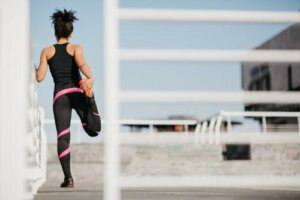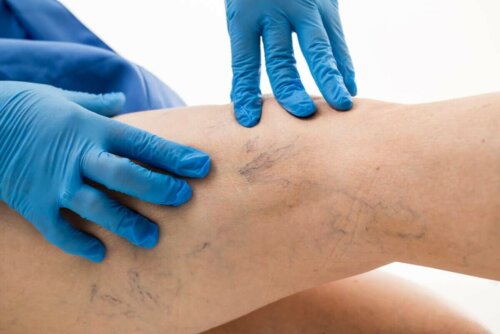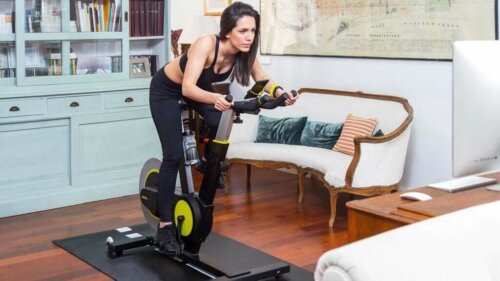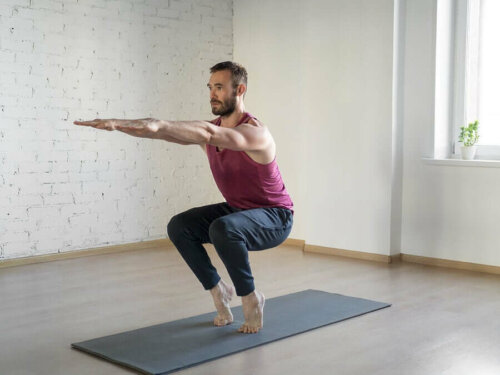9 Recommended Exercises to Treat Varicose Veins

Varicose veins are dilatations that make circulation more difficult. Furthermore, they’re more common in people, women for the most part, who sit at a desk every day. This is due to the lack of movement. Thus, exercise is one of the most efficient ways to prevent or reduce them.
Also known as the most common circulatory disease after hypertension, varicose veins are primarily caused by prolonged time standing or sitting. More importantly, if varicose veins aren’t treated, they can cause serious health problems. For example, consider thrombosis or ulcers.
The best exercises to treat varicose veins

Varicose veins are a health problem whose most frequent causes are age, hormonal changes -especially in women-, overweight, congenital circulation problems, or standing or sitting in the same position for too long, according to a MedlinePlus publication.
The importance of these factors is further confirmed by a study published in Annals of Epidemiology. This research also offers the curious fact that this problem is more common in Western countries… perhaps as a result of an unhealthy lifestyle?
Precisely, being overweight is one of the main risk factors for venous diseases, according to a study published by the European Journal of Vascular and Endovascular Surgery. Therefore, a change in habits becomes essential when starting treatment.
Physical activity is one of the most effective ways to prevent the appearance of or reduce varicose veins. Exercising helps strengthen leg muscles and promotes blood circulation, according to an article in the Merck Manual.
Intense rigorous training isn’t necessary. All it takes is some easy routines you can do at home without the need for special machines.
1. Pedaling
This is a very common exercise routine used to treat varicose veins. It consists of simulating that you are pedaling a bicycle in the air.
You can do this while laying in bed on a yoga mat. Pedal about 30 times and repeat as many times as you would like, making sure you rest in between sessions. However, if you’re a beginner in physical exercise, you can start with fewer repetitions and increase progressively.
2. Cycling

This exercise is similar to the previous one and a great one for the whole body, especially for your legs.
Make it a habit to get out every day to the park or to go shopping while riding a bike, you’ll be doing exercise without knowing it. You can do it with a friend or family member.
If you’re not really into going to the park and prefer to stay at home, you can choose to use a stationary bike, which is similar to a regular one but without enjoying the fresh air.
3. Leg separations
You can do these while sitting on a chair, on a rug, or directly on the bed. It’ll be difficult in the beginning, because it requires some strength but, with time, your legs will get stronger and it won’t be so complicated to accomplish. Here are the steps to follow:
- Firstly, lift up and spread your legs apart, then put them together by touching the tips of your toes together
- Try to do 20 repetitions, more or less depending on your physical condition
4. Treat varicose veins with leg rotations
Firstly, lay down on a yoga mat, rug or bed and lift up a leg. Then, with your leg stretched, do clockwise movements. Do 20 rotations and repeat with the other leg but with counterclockwise motions.
5. Heel-toe flexes
Like the previous ones, this exercise is good for circulation. Therefore, if you suffer from cramps, you can do it every night before going to sleep or in the morning, after getting up. It’s recommended to do these sitting down.
- Firstly, support your heels on the floor and lift up the tips of your feet
- Then relax the tips of your feet and lift your heels
- Finally, repeat 20-30 times
6. Toe flexes
This exercise to treat varicose veins is quite similar to the previous one. It’s excellent for improving venous return curve, besides toning the calf muscles. You’re to do it as follows:
- Firstly, lay down on your bed or on a rug on the floor and stretch your legs
- Then, flex your toes forwards and back, repeating this movement 20 times per leg
Read More Six Types of Squats To Give Your Legs a Workout At Home
7. Feet together
You can do these sitting or laying down, whichever way is more comfortable for you. Put together and separate repeatedly the tips of your feet and repeat this exercise 20 times.
8. Tiptoes

Although it isn’t a scientifically proven effect, some say that walking on your tiptoes or heels helps to stretch the muscles and prevent spasms. You can remain in the same spot or walk on tiptoes or heels. Repeat this as many times as you want and rest between each session.
9. Walking, jogging or swimming
All of the above activities help contract the muscles of the legs. Thus, they promote blood circulation and relieve the symptoms of varicose veins. In the case of walking, the pressure is exerted on the soles of the feet and accelerates the heart rate, improving circulation.
Swimming has a double beneficial effect, so it’s one of the best exercises for treating varicose veins. This is because the water exerts additional pressure to the contraction of the leg muscles, allowing blood to flow more efficiently.
Consult your doctor before exercising to treat varicose veins.
Beyond the benefits of physical activity, consult a doctor if your varicose veins you have are many and pronounced. This professional can evaluate your symptoms and prescribe medication as well as a special exercise routine.
Often times, people with varicose veins experience cramps or spasms. These are associated with the circulatory problem of this condition. The exercises to treat varicose veins mentioned will help relieve the ailments and, of course, lead to toned attractive legs.
However, note that not all exercises are good for varicose veins. Thus, avoid those that require physical contact, continuous jumping, or considerable physical effort such as the following:
- Soccer
- Rugby
- Basketball
- Volleyball
- Weight lifting
Habits to accompany these exercises to treat varicose veins
Beyond the unquestionable benefits of physical activity to prevent and treat varicose veins, it’s also necessary to adhere to a healthy lifestyle to reduce their likelihood.
In this regard, professionals at the Mayo Clinic recommend maintaining a healthy weight, not wearing tight clothing, and not spending long periods of time without moving your legs. Don’t forget that these habits will also benefit your general health, so we highly recommend applying them!
All cited sources were thoroughly reviewed by our team to ensure their quality, reliability, currency, and validity. The bibliography of this article was considered reliable and of academic or scientific accuracy.
- van Rij A, De Alwis C, Jiang P, Christie R, Hill G, Dutton S et al. Obesity and Impaired Venous Function. European Journal of Vascular and Endovascular Surgery. 2008;35(6):739-744.
- Beebe-Dimmer J, Pfeifer J, Engle J, Schottenfeld D. The Epidemiology of Chronic Venous Insufficiency and Varicose Veins. Annals of Epidemiology. 2005;15(3):175-184.
- Raetz J, Wilson M, Collins K. Varicose Veins: Diagnosis and Treatment. Am Fam Physician. 2019 Jun 1;99(11):682-688.
- Tisi PV. Varicose veins. BMJ Clin Evid. 2011 Jan 5;2011:0212.
- Bolton L. Exercise and Chronic Wound Healing. Wounds. 2019 Feb;31(2):65-67.
- Hamdan A. Management of varicose veins and venous insufficiency. JAMA. 2012 Dec 26;308(24):2612-21.
This text is provided for informational purposes only and does not replace consultation with a professional. If in doubt, consult your specialist.








